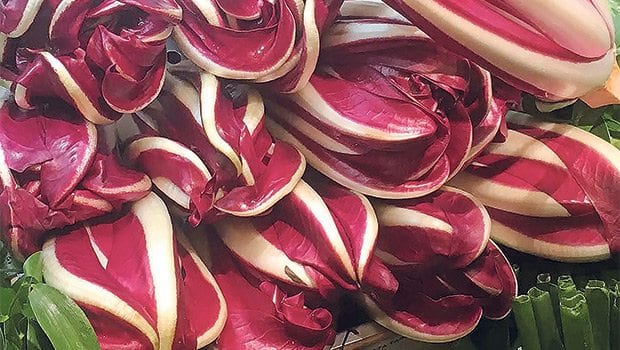
At a small vegetable shop recently in Milan, Italy, I asked the keeper for radicchio. He inquired as to what I wanted to do with it, because he had several varieties. Was I planning to grill it? Serve it with pasta? Make a salad?
My Italian isn’t up to the task of explaining my simple plan: wrap the leaves around grapefruit sections, drizzle with olive oil, and eat them. Insalata, I said, thinking that was close enough. He selected a chioggia variety for me, and I got a grapefruit, too.
This simple combination pairs the bitterness of the radicchio with the different kind of bitterness of grapefruit, creating a continuum of bitter that has the effect of dulling the flavor’s edge. The olive oil balances the grapefruit’s acid, which results in a salad-dressing-like combination of flavors. Some nuts, or grated hard cheese, would have added complexity as well, but I kept it simple. I sat on a park bench and munched my insalata, and it was good.
Big in Italy
Radicchio is also known as Italian chicory, after the broad family of crisp, bitter, leafy plants of which it’s a member. In addition to radicchio, the family includes endive and escarole, all of which are immensely popular in Italy. Some, like the Catalogna varieties, have thin leaves and robust stems, for which they are grown primarily. Others, such as cornichon endives, are grown for their roots, which are harvested in fall and buried in sawdust in a barn, then stimulated to sprout the pale, elongated heads known as Belgian endive. But most of this diverse lot are grown for their beautiful leaves, which range from purple to pink to green and yellow.
I was in Milan for the Identita Golose, a yearly conference that celebrates the Italian culinary experience. In a big lecture hall, where celebrated chefs spoke about their methods and philosophies, a background screen was lit up with a giant grilled radicchio. Not pasta. Not prosciutto, not wine. Radicchio.
The one pictured was the chiogga type, like the radicchio I ate with grapefruit. Chioggia is the most common variety found in the states. It’s the one that looks like a rosy purple cabbage. Perhaps, once, you brought one home out of curiosity, only to be repulsed by its bitter flavor.
Bitterness is a taste that we are hard-wired to reject. Babies will grimace when fed bitter foods — something they don’t do with a sweet taste in their mouths. Conventional wisdom states that we are born with a distaste for bitterness because most toxins are bitter, so this aversion allows us to steer clear of poison. But many good things are bitter, too, and we learn to make exceptions on a case-by-case basis, like chocolate, coffee and beer. In addition to these psychoactive bitter foods, many others are just plain good for you. Radicchio, for instance, is full of vitamins and minerals, and is particularly good for certain acute conditions like high blood pressure and diabetes.
Embracing bitter
As you explore the bitter side of food, you’ll realize that bitterness is not a single flavor but myriad tastes. Eventually, instead of thinking of it as bitter flavor, it will simply be flavor.
In the states, where the palate for bitterness has barely evolved beyond the examples that make you feel drunk, wired or loved, we tend to make bitter foods palatable by adding sweetness, like a honey balsamic vinaigrette. That’s fine, but also a missed opportunity to embrace that bitter flavor and expand your palate. Rather than hide from bitterness, it can be thrilling to face it head-on, and flex your taste muscles in the process.
Here is a simple Italian pasta recipe that uses chioggia, the most common chicory variety in the states and thus easiest to get a hold of. It’s a decadent dish, pink in hue and full of so much cream and cheese you won’t feel like you’re eating health food.
Bitter and Creamy Pink Pasta
- ¹⁄³ pound leek, shallot or onions
- One good-sized head of Chioggia radicchio
- Extra virgin olive oil
- One pound of pasta like fusilli, or some other textured noodle that can really grab onto the sauce
- Salt
- Thyme, to taste
- 4 Tablespoons grated aged Grana Padano, Pecorino or similar hard, aged cheese
- ½ cup cream
Mince the onion and radicchio, and saute them in the olive oil. While that’s happening, cook and drain the noodles.
When the onions are translucent and the radicchio is wilted, remove ¾ of this mixture from the pan and puree with the cream and salt.
Add the noodles to the pan and saute with the cheese and thyme. Add the pink sauce, stir around, and serve.
Ari LeVaux writes Flash in the Pan, a syndicated weekly food column that’s appeared in more than 50 newspapers in 25 states. Ari lives can be reached at flash@flashinthepan.net.






